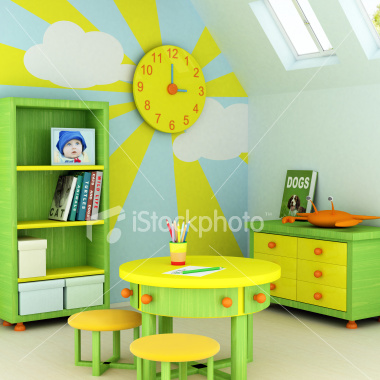Greening Your Child’s Bedroom or Baby Nursery

Whether getting a precious infant’s nursery organized or redoing your child’s bedroom, following a few green tips can help keep your kids healthy and happy in the long run. Try not to be put off by a bit of extra cost. When done well, green home improvements more than pay for themselves in peace of mind. Here are a few green tips:
• Avoid chemically-treated carpeting, especially when new. It can contain a host of toxic chemicals that off-gas directly into the room, polluting the air kids breathe. Green options include bamboo, cork, natural wool, and natural linoleum made with linseed oil. If installation glues and finishes are used, make certain they’re free of VOCs (volatile organic compounds) and other synthetic chemicals.
• Use zero or no-VOC paints. These can be latex (water-based) paints or even those made of natural materials like clay.
• If your plans call for stripping paint or tearing down a wall, first consider the age of your shelter. If it was built or last painted before the 1980s, it likely contains lead paint (known to lower IQ in children). In this case, consult a contractor certified in lead abatement.
• Steer clear of PVC. Products made with polyvinyl chloride (a plasticizer) contain a host of harmful chemicals, including VOCs and phthalates, which can pollute the air. If there’s a window in the room, install wood, cloth, or metal coverings instead of plastic shades. Instead of a vinyl shower curtain, purchase one made of organic cotton, linen, hemp, or bamboo. Likewise, avoid wallpaper made with PVC.
• Furniture should be solid wood. Avoid pressed wood made with formaldehyde glues. Purchase new furniture from certified green manufacturers. When in doubt, ask for a Materials Safety Data Sheet (MSDS) listing all ingredients in a product. Green providers will proudly show it to you.
• Avoid foam cushions in all furniture, including cribs, strollers, high chairs, and mattresses. Fire retardant chemicals found in synthetically manufactured foam products are linked to neurological and developmental impairments, learning disabilities, and cancer, according to recent studies. Some of these chemicals are gradually being phased out, but most are still widely used.
• Use un-dyed, untreated sheets and blankets made with natural fabrics. Permanent press and other treated products can contain formaldehyde that off-gasses into the air to be inhaled while children sleep.
• If you can manage it, try using cloth diapers. When you launder them, use oxygen-based bleach, not chlorine. Rinse them in the toilet after dumping waste, then soak them in a diaper pail with a tight-fitting lid, using a solution of one part distilled white vinegar to ten parts water.
• If you use disposable diapers, look for those that are chlorine- and fragrance-free.
• No matter what kind of diapers you use, flush waste down the toilet rather than putting it in the trash. It’s not good for landfills.
• And, of course, always clean your child’s room with non-toxic products made by respected companies. Commercial cleaners with a long list of unpronounceable ingredients are likely composed of questionable synthetic ingredients. Plant-based cleaning products are preferred for every room, including your child’s nursery or bedroom. Also, wipe baby’s changing area after every diaper change with a natural enzyme-based cleaner.



May 6th, 2014 at 5:27 pm
[…] First published in Green Cleaning Magazine […]